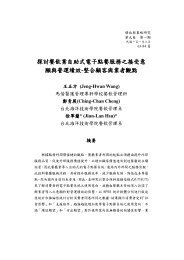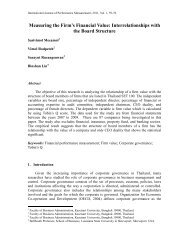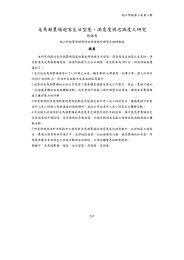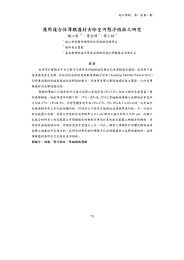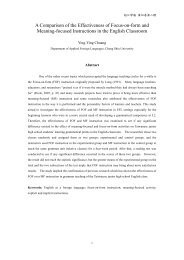ç®é - ç 究ç¼å±è - 稻æ±ç§ææ¨ç®¡çå¸é¢
ç®é - ç 究ç¼å±è - 稻æ±ç§ææ¨ç®¡çå¸é¢
ç®é - ç 究ç¼å±è - 稻æ±ç§ææ¨ç®¡çå¸é¢
Create successful ePaper yourself
Turn your PDF publications into a flip-book with our unique Google optimized e-Paper software.
稻 江 學 報 第 五 卷 第 一 期<br />
Older Adults’ Satisfaction of Web 2.0 Applications in Web-based<br />
Learning<br />
Yu-Fen Hsiao 1 、Ho-Yuan Chen 2<br />
1. Lecturer, Department of Applied Gerontology, Toko University<br />
2. Doctoral Candidate ,Department of Learning and Performance System,The Pennsylvania State University<br />
Abstract<br />
This research overviews some of the applications in Web 2.0 programs: Second Life, Wiki, Google Docs,<br />
Concept Map, and Blog, in particular. The purpose of this project is to explain the Web 2.0 technology and its impact<br />
on e-learning trends in the aging society. In the 21st century, it is important thing for nations to ensure that their<br />
citizens and with the work that they perform are informed by knowledge and skills that enable them to work and<br />
compete with others in society.<br />
The big increases in the older adults’ population have had many impacts throughout societies. Government has<br />
to take the responsibility for developing various educational activities related to lifelong learning for elder. In 1999,<br />
the United Nations (UN) recommended the elderly as learning models, and as treasures, and suggested that old adults<br />
play important roles in societies around the world. Increases in the number of older adult population have become a<br />
global issue. Many different countries including the elderly population nowadays have begun to realize that<br />
e-learning influences people’s well-being life and also accept the value and quality of educational activities provided<br />
by distance educational institutes.<br />
Moreover, Web 2.0 technology, today, has developed a new model for the elder learning environment in<br />
e-learning. Web 2.0 focuses on social connections and allows users to collaborate and create knowledge. Also, this<br />
group of programs allows personalization and user participation. The research studied some key applications related<br />
to the pedagogic use of Web 2.0 programs for older adults and describes models adapted for collaborative learning.<br />
Key word:Web 2.0 technology、elder、collaborative learning<br />
Introduction<br />
The purpose of this study was to identify perceived variables related to older adult learners’ satisfaction with<br />
Web-based learning courses which adopted Web 2.0 technology. Many educational institutes have already transferred<br />
all the learning contents to the Web-based programs. Learners can access the learning materials through the internet<br />
and have more interactions with instructors and other classmates by using the information community technologies.<br />
In recent years, more and more people included elder people have involved themselves in the live environment<br />
related to the concept of Web 2.0. “The concept of Web 2.0 began with a conference brainstorming session between<br />
O'Reilly and MediaLive International” (O’ Reilly, 2005). Coombs (2007) stated that “Web 2.0 is transforming the<br />
Web into a space that allows anyone to create and share information online--a space for collaboration, conversation,<br />
and interaction; a space that is highly dynamic, flexible, and adaptable.” (p.2) Many different software and Web<br />
services related to Web 2.0 technology: Wikipedia, Google Doc, Second Life, Podcasts, and so on. These tools not<br />
only encourage active participation in the learning process, but also allow elder learners to collaborate and create<br />
knowledge.<br />
In refer to older adults, it is the fact that the number of older adults is increasing. People are living longer than<br />
before in many countries, resulting in an aging society. In response to this situation in our society, governments are<br />
developing well-designed social support systems that include a wide range of lifelong learning opportunists in order<br />
to successfully take advantage of this human capital.<br />
The major purpose of this research was to help the elder to access various activities to face their challenges via<br />
279



